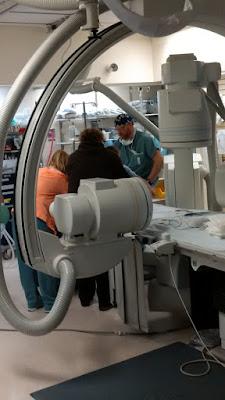Russell is a real handful during these procedures, and we expected some challenges. Anaesthesia plays a big role in the success of this day as Russell has huge anxiety. Everything leading up to the procedure went really well. We had a great discussion with the anaesthesiologist at our pre-admit clinic (PAC). I thought we had a pretty good strategy.
 |
| The Cath Lab: Here Susan is holding Russell so they can start his IV and apply the anaesthetic. |
The procedure itself went really well. No issues. We get to talk to the Cardiologist and the nurse clinicians right after the procedure, so we got some instant feedback. Lab results take a couple of weeks; but we do get some initial info from the Doctors.
Everything went sideways after the procedure, when Russell started to come out of his drug induced fog known as anaesthesia. When anaesthesia was started he went out quickly, but he went out angry. He came out just as angry. When we got Russell to recovery (PACU) he was in full bore "freak out" mode. Normally, Susan can get him calm and provide some comfort but he was having none of it. The decision happened fairly quickly to give him a sedative. This was somewhat expected and we were prepared because of the discussion we had with the anaesthesiologist at the PAC. They really listened. So a dose of midazolam was ordered up and went into Russell's IV.
With the med on board, Russell quickly settled and laid down. Here is where we got a not-so-pleasant reminder that drugs can be helpful and can scare the living daylights out of us. Russell flopped down on the bed and dozed off (or we thought he dozed off). Our bedside nurse was watching him and her body language started to change a little, she busied herself with some equipment (I wasn't really paying attention). Then the alarms started going off...alarms we were all to familiar with. On the monitor we could see "DESAT" and "APNEA." Then I realized what our nurse had busied herself with, she had grabbed an oxygen mask and was placing it over Russell's mouth and nose while she called for help. There is an old rule we learned in ICU, many years ago. "Don't freak out unless your nurse is freaking out." Maybe saying our nurse was freaking out might have been an exaggeration but she certainly wasn't calm and she had a definite sense of urgency. With some oxygen Russell's O2 saturation, which had nose dived and caused the alarms to go off, returned to normal. The whole episode probably lasted less than a minute but having seen this level of urgency before it was nothing we had ever wanted to relive. For us, it was several moments of pure terror. I don't know if Russell actually stopped breathing but it was an unnecessarily close call.
The rest of our day was relatively uneventful. The usual hospital schtick. After arriving at 8:00AM we were heading out of the door at 7:00 PM. Our day was done. We survived.
Here is the Important Part!
We had a situation happen in recovery that we thought was really serious and we didn't know why it happened. We have done 7 or 8 of these heart caths and nothing like that had ever happened. We were left trying to interpret body language and a few cryptic comments from the staff in recovery. No one offered an explanation. Honestly, we were so frazzled, we didn't ask any questions we just wanted to get out of there and get home.
The first thing to understand is that hospital staff experience incidents everyday and these may seem mundane to them, but these may be horrific and traumatic to a patient or caregiver. It doesn't matter if staff think something is routine, if you as a patient have a concern or question it deserves a thoughtful response. This is how we (as patient, caregivers, and families) learn. By having our concerns listened to and explained.
 |
| Russell recovering from his heart cath. Nicole was nice enough to bring snacks |
Within a few hours of me sending my email to our cardiologist, we had a comprehensive explanation of what happened. Keep in mind that our cardiologist was not in the recovery room. She had no idea what had happened. In her response, she described accurately what had happened based on the notes in the chart. The dosing she described was accurate from what we saw. Susan actually saw the volume of med that was infused and it aligned exactly with what our cardiologist described. The response we received was informative and seemed very consistent to what we saw at the bedside. This proved to be a very vivid reminder of the risks we take when powerful anesthetics are used and that they don't come without side effects. It is also a reminder why strict protocols are in place to closely monitor patients as they recover from surgery. There are significant risks that many times we take for granted.
Just another chapter in our adventures in health care. Would be nice to take a break but we have an appointment with Susan's Cardiologist on Thursday. Never a dull moment.
No comments:
Post a Comment